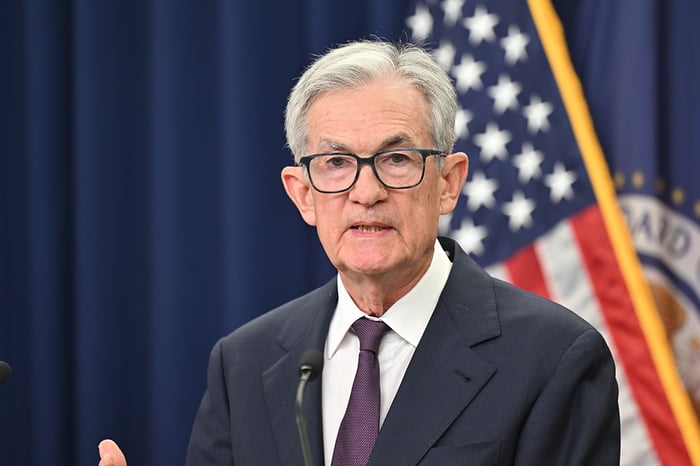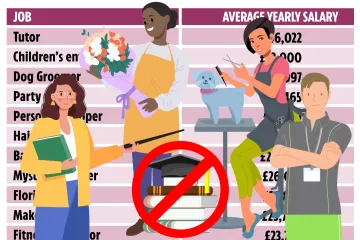These stocks will benefit in a big way from heightened economic activity.
It wasn’t a big surprise that Federal Reserve Chairman Jerome Powell cut interest rates at the Fed’s September meeting on Wednesday. In July, he implied in no uncertain terms that a rate cut was coming, and the likelihood was that it was going be a quarter of a point. That’s what has happened. The governing body also signaled that two more cuts would come at its next two meetings, in October and December.
Powell noted that there are mixed signals in the economy, which made it a difficult decision. Normally, the Fed keeps rates high until inflation backs down, and right now, inflation is higher than the Fed wants it to be. Nonetheless, the once-strong job market is beginning to falter, and a reduction in interest rates should stimulate the economy and employment opportunities.
A more active economy with more jobs and money flowing is great news for most businesses, and some companies will feel the change more acutely. Visa (V 1.19%), SoFi Technologies (SOFI 4.96%), and Carnival (CCL -2.86%) (CUK -2.67%), are three stocks that should benefit in a big way.

Image source: Getty Images.
1. Visa: The best indicator of spending habits
Visa is the largest credit card company in the world, and its performance tells the story of the economy to some degree. Because it’s a credit card network, its processed volume is a strong indication of how people are spending. And because it targets a wide range of demographics, its message is fairly universal.
The purpose of cutting interest rates is to boost the economy, and Visa is a major beneficiary of higher spending. Visa’s core business is providing the network, or infrastructure, that moves money from a customer’s partnering bank to a merchant, taking a small cut of each transaction. Although it has branched out to other services, they mostly center around different ways of moving money. More money flowing means more money for Visa.
It has been performing well despite the higher interest rates. In the 2025 fiscal third quarter (ended June 30), revenue increased 14% year over year, and payments volume was up 8%. It’s highly profitable, since it has a simple, low-cost model, and net income increased 8% over last year in the quarter.
Lower interest rates should further boost Visa’s earnings, benefiting this Warren Buffett-backed stock. Visa is a solid long-term investment, offering value to most portfolios.
2. SoFi: A young bank disruptor
Banks have a two-sided relationship with interest rates. They make more money on net interest income when rates are higher, but they also suffer from higher default rates because consumers struggle to pay back loans. They also take out loans at lower rates for that reason, and altogether, banks usually do better with lower rates.
That goes for the industry as a whole, but I’m picking SoFi in particular partly because of its large lending segment, and partly because it’s growing much faster than almost any other bank, which means it stands to gain a lot from an improving economy.
SoFi is a neobank, a cadre of digital banks that have no physical branches and offer a modern take on financial management. In addition to student, personal, and home loans, it offers a broad array of standard banking services and typically beats out national averages on savings rates for deposits.
It also offers non-standard services like cryptocurrency trading on its app, and it recently said it would offer international money transfers on a Blockchain network. That could offer real value, since sending money internationally is often a complicated, expensive, and long process.
SoFi’s lending segment struggled last year when interest rates were at a high, and it has already benefited from lower rates with accelerated revenue growth and better credit metrics. Even lower rates should help all of its segments, which, aside from lending, include financial services, like bank accounts and investing, and tech platform, which is a business-to-business financial infrastructure.
As it becomes a larger and more formidable player in finance, it should be able to weather future uncertainty even better.
3. Carnival: Great performance, high debt
Carnival is sailing through smooth seas as customers continue to sign up for its cruises. Demand is at historical highs, operating income is at a record, and the company is ordering new ships and launching new destinations to meet all of this demand.
There’s only one kink in the business: it has massive debt. It’s been paying it off responsibly, but it’s still more than $27 billion. This year, it has refinanced $7 billion at better rates, saving millions on interest. It will now be able to refinance more of its debt at lower rates.
Outside of the debt, the investment thesis for Carnival is strong. It’s the largest global cruise operator, and demand has stayed healthy despite high inflation. That’s resiliency.
Carnival stock is still cheap today due to the concerns about the debt, but as it pays it down and becomes more profitable, expect the stock to keep climbing.










